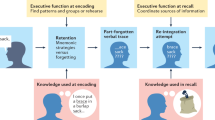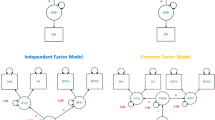Abstract
Working memory (WM), the process by which information is coded into memory, actively maintained and subsequently retrieved, declines with age. To test the hypothesis that age-related changes in prefrontal cortex (PFC) may mediate this WM decline, we used functional MRI to investigate age differences in PFC activity during separate WM task components (encoding, maintenance, retrieval). We found greater PFC activity in younger than older adults only in dorsolateral PFC during memory retrieval. Fast younger subjects showed less dorsolateral PFC activation during retrieval than slow younger subjects, whereas older adults showed the opposite pattern. Thus age-related changes in dorsolateral PFC and not ventrolateral PFC account for WM decline with normal aging.
This is a preview of subscription content, access via your institution
Access options
Subscribe to this journal
Receive 12 print issues and online access
$209.00 per year
only $17.42 per issue
Buy this article
- Purchase on Springer Link
- Instant access to full article PDF
Prices may be subject to local taxes which are calculated during checkout






Similar content being viewed by others
References
Raz, N. et al. Selective aging of the human cerebral cortex observed in vivo: Differential vulnerability of the prefrontal gray matter. Cereb. Cortex, 7, 268–282 (1997).
Heilbroner, P. L. & Kemper T. L., The cytoarchitectonic distribution of senile plaques in three aged monkeys. Acta Neuropathol. 81, 60–65 (1990).
Haug, H. & Eggers, R. Morphometry of the human cortex cerebri and corpus striatum during aging. Neurobiol. Aging 12, 336–338 (1991).
Goldman-Rakic, P. M., & Brown, R. M. Regional changes of monoamines in cerebral cortex and subcortical structures of aging rhesus monkeys. J. Neurosci, 6, 177–178 (1981).
Waugh, N. C. & Norman, D. A. Primary memory. Psychol. Rev. 72, 89–104 (1965).
Glanzer, M. & Razel, M. The size of the unit in short term storage. J. Verb. Learn. Verb. Behav. 13, 114–131 (1974).
Craik, F. I. M. & Jennings, J. M. in The Handbook of Aging and Cognition (eds. Craik, F. I. M. & Salthouse, T. A.) 51–110 (Erlbaum, Hillsdale, New Jersey, 1992).
Awh, E. et al. Dissociation of storage and rehearsal in verbal working memory: evidence from PET. Psychol. Sci. 7, 25–31 (1996).
Paulesu, E., Frith, C. & Frackowiak, R. The neural correlates of the verbal component of working memory. Nature 362, 342–345 (1991).
Rypma, B., Prabhakaran, V., Desmond, J. E., Glover, G. H. & Gabrieli, J. D. E. Load-dependent roles of prefrontal brain regions in the maintenance of working memory. Neuroimage 9, 216–225 (1999).
Rypma B. & D'Esposito, M. The roles of prefrontal brain regions in components of working memory: Effects of memory load and individual differences. Proc. Natl. Acad. Sci. USA 96, 6558–6563 (1999).
D'Esposito, M., Postle, B. R., Ballard, D. & Lease, J, Maintenance versus manipulation of information held in working memory: An event-related fMRI study. Brain Cognit. 41, 66–86 (1999).
Anders, T. R., Fozard, J. L. & Lillyquist, T. D. Effects of age upon retrieval from short-term memory. Dev. Psychol. 6, 214–217 (1972).
Van der Linden, M., Bredart, S. & Beerten, A. Age-related differences in updating working memory. Br. J. Psychol. 85, 145–151 (1994).
Fuster, J. M. The Prefrontal Cortex: Anatomy, Physiology, and Neuropsychology of the Frontal Lobes (Raven, New York, 1989).
Smith, E. E. & Jonides, J. Storage and executive processes in the frontal lobes. Science 283, 1657–1661 (1999).
Petrides, M. in Handbook of Neuropsychology (eds. Boller, F. & Grafman, J.) 75–90 (Elsevier, Amsterdam, 1989).
Owen, A. M., Evans, A. C. & Petrides, M. Evidence for a two-stage model of spatial working memory processing within the lateral frontal cortex: a positron emission tomography study. Cereb. Cortex 6, 31–39 (1996).
Belsley, D. A., Kuh, E. & Welsch, R. E. Regression Diagnostics: Identifying Influential Data and Sources of Collinearity (Wiley, New York, 1980).
Sternberg, S. High speed scanning in human memory. Science 153, 652–654 (1966).
Salthouse, T. A. The processing speed theory of adult age differences in cognition. Psychol. Rev. 103, 403–428 (1996).
Myerson, J., Hale, S., Wagstaff, D., Poon, L. W. & Smith, G. A. The information-loss model: a mathematical theory of age-related cognitive slowing. Psychol. Rev. 97, 475–487 (1990).
Servan-Schreiber, D., Printz, H. & Cohen, J. D. A network model of catecholamine effects: gain, signal to noise ratio, and behavior. Science 249, 892–895 (1990).
Cohen, J. D. & Servan-Schreiber, D. Context, cortex, and dopamine: A connectionist approach to behavior and biology in schizophrenia. Psychol. Rev. 99, 45–77 (1992).
Kimberg, D. Y., D'Esposito, M. & Farah, M. T. Effects of bromocriptine on human subjects depend on working memory capacity. Neuroreport 8, 3581–3585 (1997).
Mitchell, K. J. et al. Aging and reflective processes of working memory: Binding and test load deficits. Psychol. Aging (in press).
Zarahn, E., Aguirre, G. K. & D'Esposito, M. A trial based experimental design for functional MRI. Neuroimage 6, 122–138 (1997).
Worsley, K. J. & Friston, K. J. Analysis of fMRI time-series revisited-again. Neuroimage 2, 173–182 (1995).
Aguirre, G. K., Zarahn, E. & D'Esposito, M. The variability of human BOLD hemodynamic responses. Neuroimage 8, 360–369 (1998).
Talairach, J. & Tournoux, P. Co-Planar Stereotaxic Atlas of the Human Brain (Thieme, New York, 1988).
Kleinbaum, D. G., Kupper, L. L. & Muller, K. E. Applied regression analysis (Duxbury, Belmont, California, 1988).
D'Esposito, M., Zarahn, E., Aguirre, G. K. & Rypma, B. The effect of normal aging on the coupling of neural activity to the BOLD hemodynamic response. Neuroimage 10, 6–14 (1999).
Acknowledgements
This research was supported by American Federation for Aging Research and NIH grants NS01762, AG15793 and AG13483. We thank Jeffrey S. Berger, Ron Collis, David Dorfman, Eric Zarahn and Geoff Aguirre for their support on this project. We thank Marcia K. Johnson, Karen Mitchell and Carol Raye for the design of replication experiment 2.
Author information
Authors and Affiliations
Corresponding author
Rights and permissions
About this article
Cite this article
Rypma, B., D'Esposito, M. Isolating the neural mechanisms of age-related changes in human working memory. Nat Neurosci 3, 509–515 (2000). https://doi.org/10.1038/74889
Received:
Accepted:
Issue Date:
DOI: https://doi.org/10.1038/74889
This article is cited by
-
Cognitive Deficits and Alzheimer’s Disease-Like Pathologies in the Aged Chinese Tree Shrew
Molecular Neurobiology (2023)
-
The modulatory effect of adaptive task-switching training on resting-state neural network dynamics in younger and older adults
Scientific Reports (2022)
-
Investigating the effects of healthy cognitive aging on brain functional connectivity using 4.7 T resting-state functional magnetic resonance imaging
Brain Structure and Function (2021)
-
A novel paradigm for assessing olfactory working memory capacity in mice
Translational Psychiatry (2020)
-
Reductions in prefrontal activation predict off-topic utterances during speech production
Nature Communications (2019)



